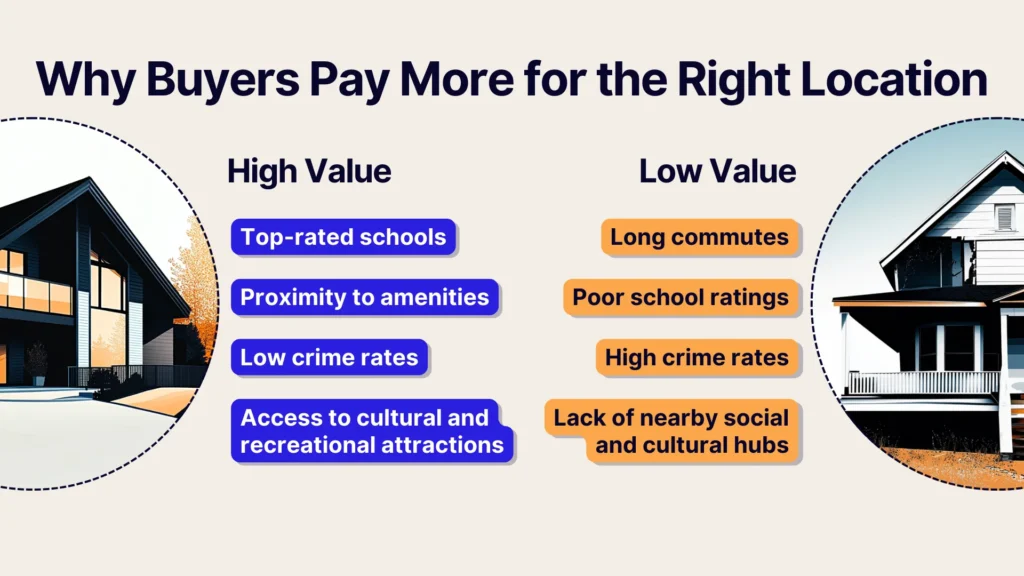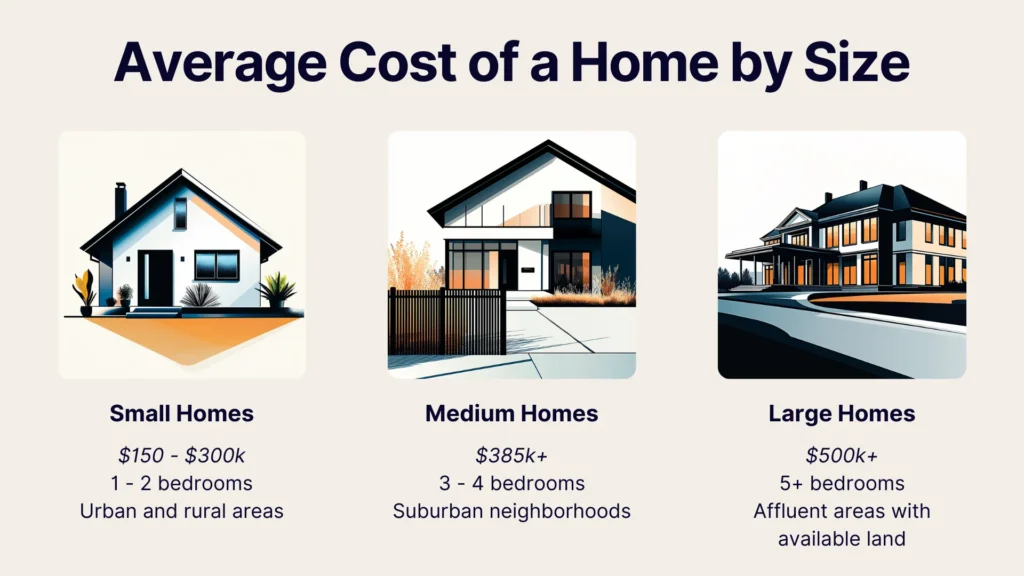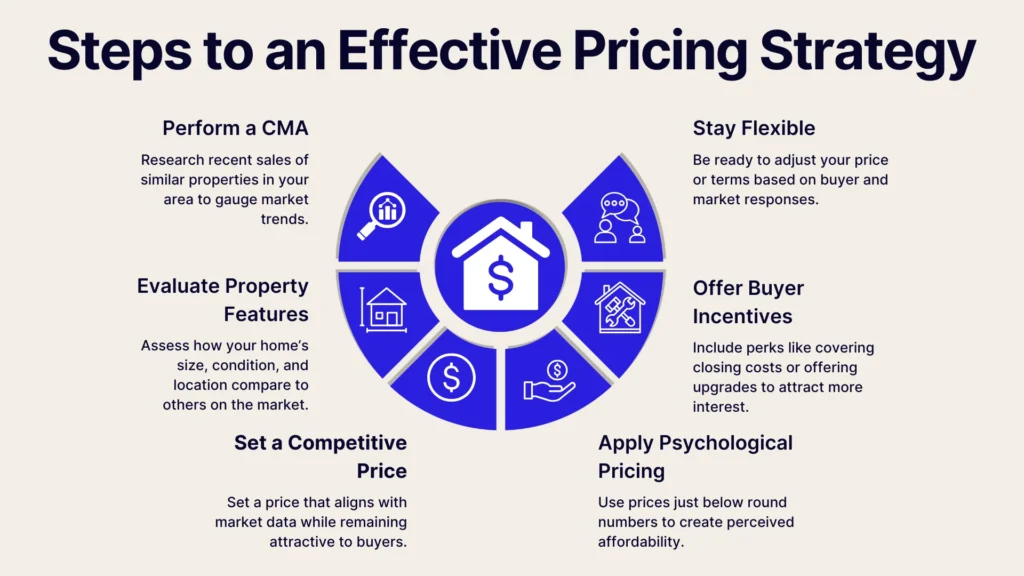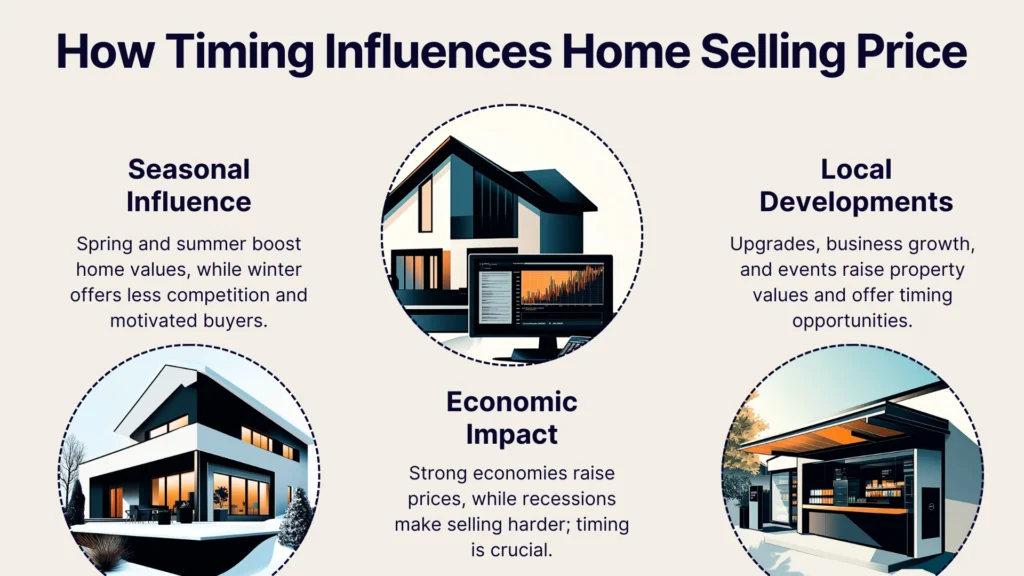Selling a home involves one of the most important financial decisions many individuals make. Knowing the factors that determine a home’s selling price is vital for homeowners, real estate agents, and potential buyers. From location to market dynamics, every element plays a role in shaping the value of a property.
In this article, we’ll explore the primary factors affecting home prices and why buyers consider them when choosing a home. We’ll talk about the impact of market conditions, location, and how to market your home effectively to get the best possible selling price.
Why Location Matters
Location significantly influences a property’s value. Buyers prioritize homes in attractive areas and are often willing to pay more for desirable surroundings, which is why convenience and safety are two of the main aspects that contribute to a location’s value. Let’s dive into why location is so important:

Proximity To Amenities
Homes close to essential amenities, such as grocery stores, parks, healthcare facilities, and public transportation, tend to command higher prices. Convenience enhances buyers’ quality of life and reduces commuting time, making these properties highly sought after.
Being near shopping centers, restaurants, and entertainment venues adds appeal to a property. Buyers often favor neighborhoods that offer easy access to vibrant social and commercial hubs. Recreational facilities, like sports complexes and fitness centers, further boost a home’s desirability. Additionally, proximity to cultural landmarks, museums, or community centers can increase demand, as these amenities foster a sense of community and enhance the neighborhood’s attractiveness.
School District Quality
Families consider the quality of local schools when purchasing a home. Properties in top-rated school districts often sell faster and at higher prices. Even buyers without children recognize the long-term value of homes in areas with excellent educational institutions. Proximity to private schools or universities can also elevate a property’s market appeal. School-related infrastructure improvements, such as new facilities or expanded curricula, often correlate with rising property values in the surrounding area.
Crime Rates
Safety plays a key role in determining a home’s value. Buyers prefer neighborhoods with low crime rates, as they promise peace of mind and a better quality of life. Features like neighborhood watch programs, gated communities, and visible law enforcement can further enhance a property’s appeal. Also, local initiatives aimed at improving community safety, such as increased street lighting or community policing efforts, can contribute to rising property values over time.
How Property Condition Influences Selling Price
The physical state of a home directly impacts its market value. Buyers are willing to pay a premium for properties that are move-in ready and well-maintained. Here’s how age, upgrades, and maintenance can affect your selling price:
Age Of The Property
Older homes may attract buyers seeking charm and character but can also raise concerns about maintenance. Newer homes generally command higher prices due to modern features and reduced repair needs. Preserved historical homes, however, can capture the attention of niche buyers who value uniqueness.
Homes with retrofitted modern systems, such as updated electrical wiring or plumbing, can balance the charm of age with the practicality of modern living.
Recent Renovations Or Upgrades
Renovations can significantly boost a home’s value. Modern kitchens, updated bathrooms, and energy-efficient systems often attract buyers willing to pay more. Upgrades like solar panels, new appliances, or improved insulation appeal to eco-conscious buyers, increasing a home’s marketability.
Landscaping improvements, such as a well-maintained garden or outdoor entertaining areas, can also enhance curb appeal, drawing more interest and higher offers.
Maintenance History
Buyers look for homes with a solid maintenance history. Regular upkeep – such as roof repairs, HVAC servicing, and plumbing checks – indicates that a property is less likely to have hidden problems. Transferable warranties for major systems add further value, giving buyers confidence in their purchase. Detailed records of past maintenance or upgrades can also provide reassurance to potential buyers, highlighting the seller’s commitment to keeping the home in excellent condition.
The Impact of Market Conditions
Market dynamics shape home prices by influencing both buyer behavior and seller expectations. Here are more detailed explanations of why economic trends and real estate conditions play pivotal roles in your home’s final selling price:
Current Interest Rates
Interest rates affect buyers’ purchasing power. Lower rates make mortgages affordable, increasing demand and driving up prices. On the other hand, higher rates reduce affordability, potentially lowering property values. Buyers frequently consult financial advisors to understand how interest rates impact their budgets. Trends in fixed versus adjustable-rate mortgages can greatly influence buyer preferences and the pace of sales.
Housing Supply And Demand
The balance of housing supply and demand dictates market trends. In a seller’s market, limited inventory drives up prices, while in a buyer’s market, abundant options can lead to price reductions. Inventory levels, measured in months of supply, serve as a critical metric for understanding market conditions. New housing developments or construction projects can also shift this balance, influencing prices in localized areas.
Economic Forecasts
Economic indicators such as job growth and consumer confidence can impact the real estate market. A robust economy fosters demand for homes, while uncertainty can depress prices. Local economic events, like major employer expansions or closures, also influence property values in specific areas. For instance, the announcement of a new tech hub or manufacturing plant can lead to a surge in demand for nearby housing, driving up prices.
Home Size And Usable Space
The size and layout of a home are a primary factor in determining its market value. Buyers assess properties based on their ability to meet personal and functional needs. Let’s dive into how your layout and home size impact your home sale:

Square Footage
Larger homes typically fetch higher prices due to their additional living space. However, how the space is utilized can affect its value. Finished basements, attics, and other well-designed areas add significant appeal in competitive markets.
Buyers often prioritize homes with ample storage solutions, such as walk-in closets or built-in shelving, as these features enhance daily functionality.
Number Of Bedrooms And Bathrooms
The number of bedrooms and bathrooms directly impacts a home’s appeal. Families often prioritize homes with multiple bedrooms and bathrooms to suit their needs. Properties with features like en-suite bathrooms or extra half-baths attract higher offers. The inclusion of bonus rooms, such as a guest suite or playroom, can significantly boost a property’s attractiveness and value.
Layout And Design
Buyers prefer homes with practical layouts and modern designs. Open floor plans, natural lighting, and functional spaces like home offices or walk-in closets significantly boost a property’s value. Homes with awkward or inefficient designs may struggle to achieve competitive prices. Buyers are increasingly seeking homes with versatile spaces that can adapt to different needs, such as gym areas or creative workspaces.
The Importance of Effective Marketing
Marketing plays a vital role in attracting buyers and maximizing a home’s selling price. Effective strategies highlight a property’s strengths and create broad exposure. Visual appeal is essential; high-quality photos can make or break a listing. Professional photography showcases a property’s best features and increases interest. Tools like virtual tours and drone footage provide comprehensive perspectives, helping buyers visualize the home. Eye-catching images often generate more clicks on online platforms, boosting the number of potential buyers.
Descriptions must emphasize a home’s unique features. Highlighting benefits like proximity to amenities, updated appliances, or energy-efficient systems makes listings more attractive. Including neighborhood details, such as community events or parks, further enhances appeal. Clear and concise language that avoids jargon ensures the listing appeals to a broader audience.
A strong marketing plan involves both digital and traditional approaches. Social media promotions, online listings, and open houses reach wide audiences, increasing the chances of competitive offers. Networking with local agents and leveraging direct mail campaigns can also generate interest. Furthermore, targeted advertising on real estate platforms can attract buyers with specific preferences, such as location or property size.
Why Pricing Strategy Makes A Difference
The right pricing strategy can make all the difference in a home sale. Overpricing may scare off buyers while underpricing leaves money on the table. Many home sellers consider pricing their property correctly to be the most difficult part of the selling process.

A comparative market analysis (CMA) examines similar properties to set a competitive price. Factors like location, size, and condition inform this analysis. Tools such as heat maps and trend graphs provide insights into local market behaviors. Sellers who invest time in understanding their market position are more likely to price competitively and attract serious buyers.
Setting an asking price just below a round number (e.g., $299,000 instead of $300,000) can make a property appear more affordable. Offering incentives like covering closing costs can also sway buyers. These strategies attract attention and help drive interest. Limited-time offers or deadlines can create urgency, prompting quicker decisions from buyers.
How Timing Influences Selling Price
Timing matters greatly in real estate. Seasonal patterns, economic conditions, and local events often determine when homes sell at their highest values. Spring and summer are prime seasons for home sales. Longer days and pleasant weather encourage buyers to visit properties. Families aiming to move before the school year can drive demand during these months. Winter sales, though slower, benefit from reduced competition among sellers. Also, the holiday season may attract motivated buyers to finalize transactions before year-end deadlines.

Strong economies with low unemployment rates boost home prices. Conversely, buyers may hesitate during recessions or economic downturns, and sellers face pricing challenges. Understanding economic cycles helps sellers time their listings for maximum return. Monitoring market trends, such as employment rates or consumer spending, provides valuable insights into optimal selling periods.
Events such as infrastructure upgrades or new business developments can increase property values in certain areas. Monitoring local government initiatives or upcoming projects provides insights into the best times to list a property. Community events like festivals or new transportation options can also temporarily boost neighborhood visibility and desirability.
Conclusion
A home’s selling price results from a combination of factors, including location, condition, market trends, size, marketing efforts, pricing strategy, and timing. Understanding these elements allows sellers to position their properties effectively and achieve success in competitive markets.
Buyers look for functional layouts, versatile spaces, and the right size to meet their needs. Show off what your home has to offer with Propbox. Our automated platform simplifies the process, ensuring your property reaches the right buyers quickly. Skip the 6% fees, sell for more, and take control of your listing. Make selling easier, faster, and more profitable with Propbox.
